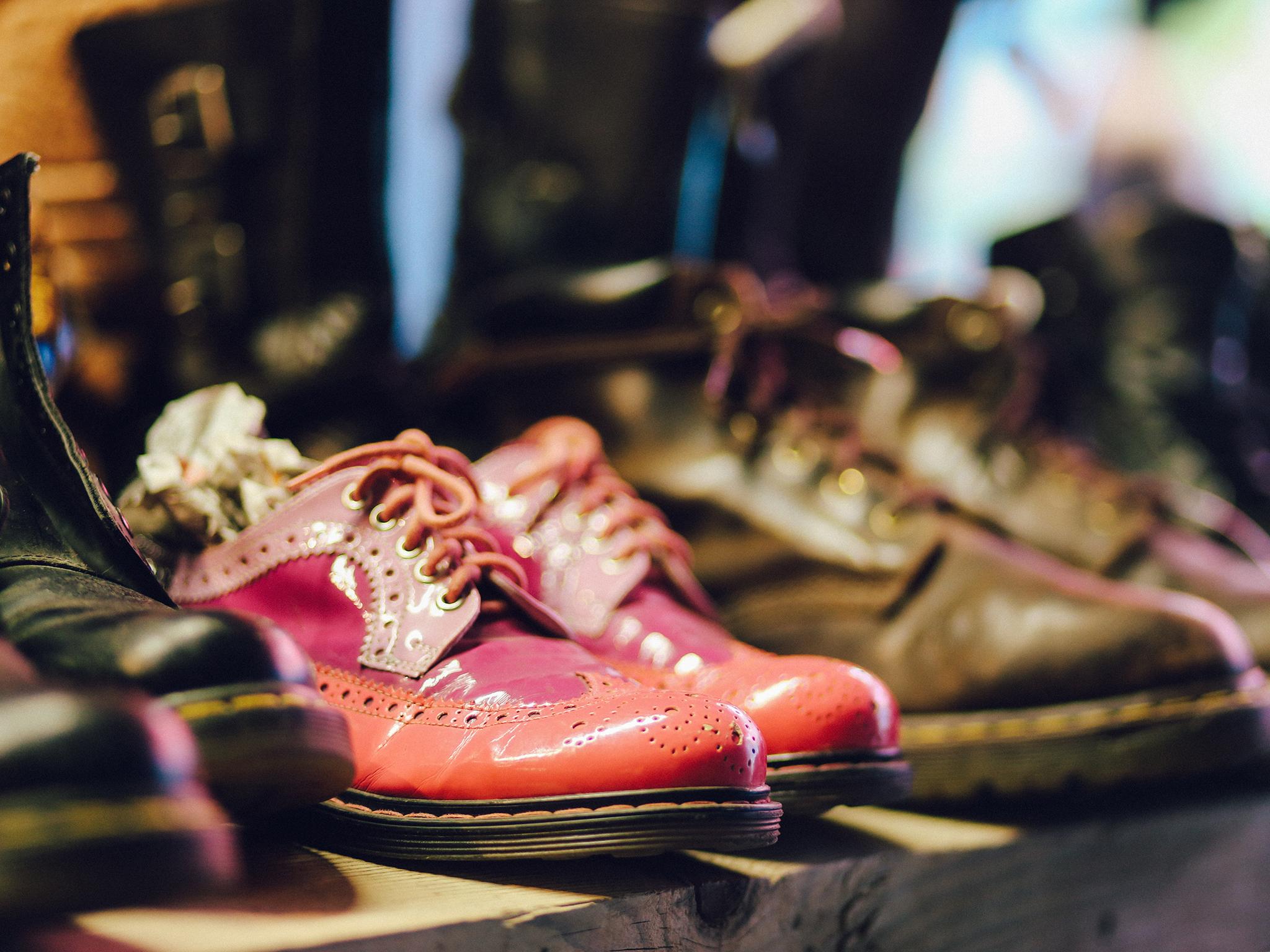Social media has brought charity shops back to life – and made second hand shopping even more addictive
Online groups are revolutionising the second hand market, and sharing your finds has become somewhat of an addiction. What does this ‘phenomenon’ say about our most fundamental human desires, asks Irena Barker

For me, the charity shop obsession started with velvet blazers. It was about 1994, I was 16 and I was desperate to complete my female Jarvis Cocker-in-a-floral skirt indie look.
As a student, I went through a silly ornaments stage – the bigger and sillier the better: the mocking face of a drunk plaster of Paris pirate stared down at us in our student house for an entire year.
When I lived in France after graduation, I furnished my shared house with heavy baronial dining chairs from the Emmaus second hand depot in Limoges.
I remember the rush of buying these hefty thrones made me feel superhuman as I hauled them through the blazing sun.
Now I am a broke mum of three, unable to afford anything other than what the “chazzas” have to offer. As I age, crockery and cooking items have become my affliction. I spent a year searching for the perfect £2 Bodum butter dish in our local Sue Ryder. The day I saw it, in all its transparent plastic glory, was one to be savoured.
I now have everything I need, but still, I return. If anything, for the sheer entertainment of not knowing quite what I will find. I am far from alone in this mania, of course, charity shops are hugely popular – there are 11,200 in the UK and they raise £295m for good causes.
In a country still under the cosh of austerity, quivering with Brexit uncertainty, numbers of charity shops are holding relatively steady as the big beasts of retail such as BHS and House of Fraser go under. And as Greta Thunberg tells us we will be fried by global warming if we don’t rein in our shopping addiction, second hand seems like the safest option.
But it seems that the advent of social media has brought a whole new level of excitement to walking into a charity shop: the opportunity to share your finds with like-minded fanatics the world over.
On Instagram, variations on #charityshop are many, and posts often feature the buyers posing smugly in their bargain clothing purchases.
But Facebook has a particularly intriguing proliferation of groups dedicated to people sharing their fabulous, nostalgic, ugly and often downright disturbing finds.
Much of it seems to have started with the now famous Terrible Art in Charity Shops group (62,000 members), which is dedicated to the worst examples of amateur painting and drawing that members can find. I found it an amusing and sometimes stomach-churning place to be.
But others have now expanded the brief.

One of the largest groups, with the straightforward title Charity Shop Shit has accrued 51,000 members since it was set up in September 2018. Members are challenged to find the weirdest and funniest things in charity shops and post pictures for others to “admire”.
The page is a hilarious, yet sometimes a troubling, landscape of ghastly 1970s album covers, ugly teapots with suggestive spouts, appalling knick-knacks, scary dolls, owls and strange unidentifiable items.
A man named Jim pops up occasionally modelling a cheerleading outfit, then lederhosen. There is a trend for showing off fleece jackets featuring wolves (a charity shop staple, apparently).
Items also appear that have been discovered by volunteers sorting through charity shop donations behind the scenes: a half-used tub of Vaseline or some shrivelled up loafers that look ready for the recycling bin, not the shop floor.
Eye-catching posts can garner hundreds of comments and there is an instant sense of community as members share jokes and thoughts about the items and the memories they evoke.
There is a weird tension between younger and older members of the group as millennials pretend (are they pretending?) they can’t identify a hole punch or a cassette tape and stand back as older members pile in to tell them.
The things that are in the shop are perhaps representing the end of someone’s life but then someone else comes in to cherish those things
Another Facebook group, Random Crap Found in Charity Shops, has over 8,000 members, and features a similarly weird buffet of strange items, from William Hague mugs to 1970s knitting patterns modelled by kids with bowl haircuts.
A US-based group dedicated to thrift store and yard sales – Weird Second Hand Finds that Need to be Shared – has 190,000 members.
But while these groups primarily go for entertainment, others merely seek to celebrate bargains among the like-minded.
Charity Shop Not So Shit Finds is a good example. Fans post pictures of their collections of Cath Kidston mugs bought in charity shops; a nearly new Boden jacket bought for £8; a tasteful ornament for the mantelpiece. It is a gentle and encouraging place to be where no one laughs at your slightly off-key taste in glassware.
After joining some of these groups and letting their seemingly endless posts flood my news feed with ugly piggybanks, ornamental owls and suggestive lemon squeezers, I began to ask myself: why am I enjoying this so much?
Scrolling through pictures of what is, essentially, tat, was the most satisfying scrolling I had ever undertaken on the internet.
When I walked into a charity shop after joining the groups, my eyes leapt through the bric-a-brac with a new vigour. Only shyness stopped me taking a picture of a rather forlorn ceramic pig. And besides, I couldn’t decide which of the groups would appreciate its doleful eyes the most.
The numbers suggest many others feel exactly as I do. So I wanted to find out what people get out of rummaging through charity shops and sharing their finds on social media. What is missing from our lives that is fulfilled by this? And what is the allure of looking at the finds?

Could this phenomenon, if we can call it that, be saying anything deeper about modern life, modern retail; about our most fundamental human needs and desires?
I spoke to student Poppy Greenstreet, an admin for Charity Shop Shit whose mum Natalie Stapley set up the group.
For her, the explanation is pretty simple: the appeal both reflects the huge popularity of charity shops themselves, their presence in almost every UK town centre and the “sheer entertainment value” of the finds. There is a sense of being in a supportive community of like-minded people too, she says.
But there is also a strong element of competition between members.
This was most evident when posters became obsessed with finding albums from the popular 1960s and 1970s entertainer, Mrs Mills, and the group overflowed with pictures of them.
She says: “It got to the point when people were getting so competitive... and there were arguments… they were posting 10 to 20 times a day to the group.”
They eventually had to ban Mrs Mills so the group remained entertaining to those who may have started to grow tired of her plump and cheery face.
There can be a witty clever sharing of our history in charity shops, about quirkiness, about things we’ve let go of that we’re sorry we did. Charity shops are maybe museums that tell us a lot about ourselves, good and bad
The sense of competition is enhanced by some groups who celebrate the “best” finds of the week, or set challenges to members such as finding the worst decorative plates. Nostalgia has emerged as a key theme in many of the groups. When retro items are posted (as many inevitably are) they prompt memories and recollections.
“It’s part of the enjoyment,” says Sarah Portsmouth, founder of Charity Shop Not So Shit Finds, from Llandovery in south Wales. “For me it’s melamine, the feel and sound of melamine… It’s things from childhood, it’s sensory experiences from childhood.”
And while it may be melamine for Sarah, others are stirred by a Noel Edmonds’ Funny Phone Calls record, a Kylie and Jason wall clock or a popular table lamp they grew up with in the 1960s.
While there’s a fair amount of mockery of these items, there’s a fair amount of love, too.
For Luisa Thorpe, a former librarian and founder of Random Crap Found in Charity Shops, the appeal of the group is the stories that the posted items provoke.
She says: “Some of the items are actually really sad. We’ve had wedding photographs where the heads have been torn off. Then, of course, once people start chatting on that thread they start telling you their stories and that’s what I particularly love. It’s a nice forum for people to offload and to share.”

There is also clearly a strong affection for some of the items that comes over on the groups, however ugly they are.
People confess openly to having bought things of dubious taste out of pity for the item itself. On one US-based group, a woman posted a picture of an odd-looking macramé skeleton she had bought – to the delight of the shop assistant who was sick of the sight of it.
Charity shop shopping, it seems, is a highly emotive and not entirely rational experience. If you have a sudden urge to buy something, no matter how silly, you simply have to buy it.
Sarah Portsmouth tells me: “For some people charity shop shopping is about giving a loving home to things that are no longer loved. Here in Llandovery, you see another house clearance come in to the Red Cross shop and you think that in itself is quite sad.
“The things that are in the shop are perhaps representing the end of someone’s life but then someone else comes in to cherish those things. I think a lot of the little knick-knacks that people are falling for again have gone past the stage of being old-fashioned, and people seeing them as little treasures again.”
For many though, their love of charity shop shopping is a response to the homogenisation of the high street and the cold predictability of online shopping.
Ms Portsmouth added: “You get a better sense of satisfaction in a charity shop because you weren’t expecting to buy certain things, you find a pair of shoes that have never been worn which would be £80 from the local shoe shop, and there they are for £5. There’s definitely the warm and fuzzy factor over finding treasure.”
Gill Perkins, CEO of the Wandsworth Oasis chain of 10 charity shops in southwest London, agrees: “You never know what you’re going to find. It’s the old-style charity shops full of stuff not all beautifully arranged that are the best… you might find something in a dark corner in a box of 20 other things… that’s where you’re likely to find the little gems, not in the boutiques,” she says.
For some, it is the very scarcity of good items in charity shops that have made the hunt more fun and the kudos greater when the item is shared.
London-based arts educator and self-confessed “charity shop aficionado” Anna Marlen-Summers compares charity shopping to “hunting with trophies”.
“We love the hunt and rush of getting a bargain. It’s a thing now because all the retro and vintage shops get the good stuff and it’s so much rarer to find something good,” she says. “We want appreciation for our trophies and with digital media we can get this from loads of people, not just visitors to our house.”
Charity shopping is a way to express our uniqueness within this bland identikit culture, she adds.
“With all the simple repetitive things from Ikea that our homes are full of, we love a chintzy thing no one else can have. I win! Again, it’s a trophy. I am unique, not a stupid rented flat replicate like my furniture would suggest.”
Academic Paul Levy, author of the book Digital Inferno, says that our addiction to constant social media “likes” combined with austerity and the trend towards recycling makes it unsurprising that charity shops have become “the new playground for photography”.
There is a reaction against standardisation and mass production too that is fuelling interest, the lecturer at the University of Brighton Business School says. He says the trend for sharing the “worst” finds allows people to “show off how smart they’ve been… how good they are at identifying crap”.
“The notion of pointing to shit, being a reporter of shit, that route of darkness and negativity, if it’s done cleverly and wittily people celebrate that,” he says.
The whole idea of laughing at old and obsolete technology is interesting too, he says. “There can be a witty clever sharing of our history in charity shops, about quirkiness, about things we’ve let go of that we’re sorry we did. Charity shops are maybe museums that tell us a lot about ourselves, good and bad.”
Whatever the drivers behind this trend, the charity shops themselves seem only set to benefit from the online interest.
Robin Osterley, chief executive of the Charity Retail Association, which represents charity shops in the UK, says that they “are now a UK institution”. The love on social media is a reflection of that, he says.
“When you buy something in a charity shop it has the power to evoke either happy memories of the past or delight in grabbing a bargain. The affection held by the local community for our members’ shops is unique and one we should protect and cherish.”
I couldn’t agree more. Now where did I put that weird owl in a bell jar?
Join our commenting forum
Join thought-provoking conversations, follow other Independent readers and see their replies
Comments